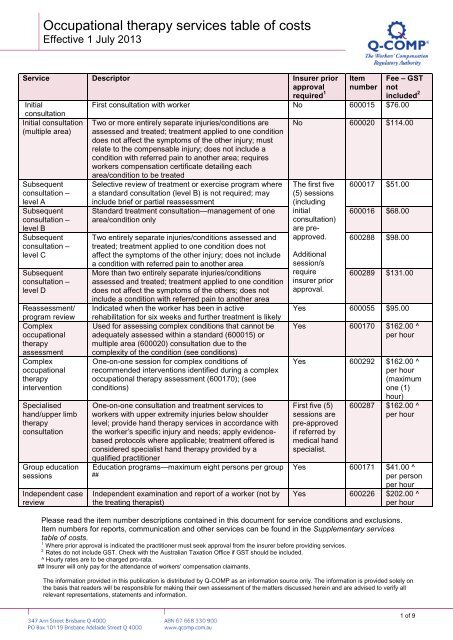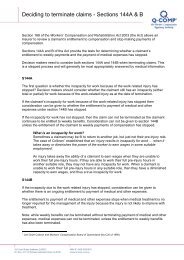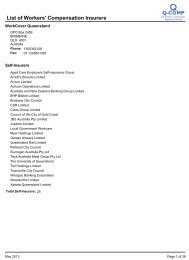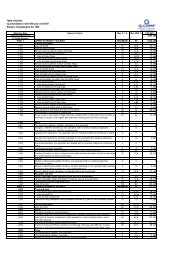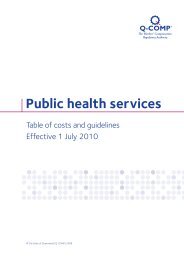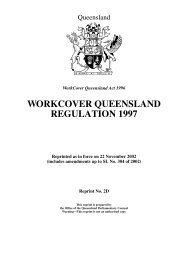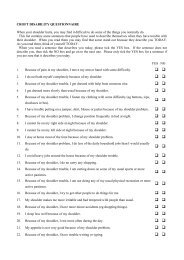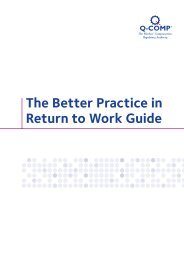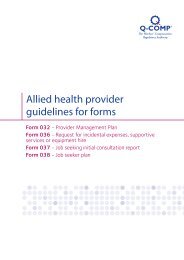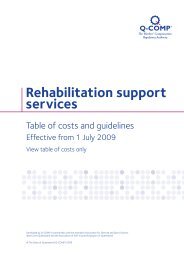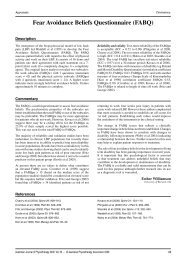Occupational therapy services table of costs - Q-Comp
Occupational therapy services table of costs - Q-Comp
Occupational therapy services table of costs - Q-Comp
You also want an ePaper? Increase the reach of your titles
YUMPU automatically turns print PDFs into web optimized ePapers that Google loves.
<strong>Occupational</strong> <strong>therapy</strong> <strong>services</strong> <strong>table</strong> <strong>of</strong> <strong>costs</strong><br />
Effective 1 July 2013<br />
Service Descriptor Insurer prior<br />
approval<br />
required 1<br />
Initial<br />
consultation<br />
Initial consultation<br />
(multiple area)<br />
Subsequent<br />
consultation –<br />
level A<br />
Subsequent<br />
consultation –<br />
level B<br />
Subsequent<br />
consultation –<br />
level C<br />
Subsequent<br />
consultation –<br />
level D<br />
Reassessment/<br />
program review<br />
<strong>Comp</strong>lex<br />
occupational<br />
<strong>therapy</strong><br />
assessment<br />
<strong>Comp</strong>lex<br />
occupational<br />
<strong>therapy</strong><br />
intervention<br />
Specialised<br />
hand/upper limb<br />
<strong>therapy</strong><br />
consultation<br />
Group education<br />
sessions<br />
Independent case<br />
review<br />
Item<br />
number<br />
Fee – GST<br />
not<br />
included 2<br />
First consultation with worker No 600015 $76.00<br />
Two or more entirely separate injuries/conditions are<br />
assessed and treated; treatment applied to one condition<br />
does not affect the symptoms <strong>of</strong> the other injury; must<br />
relate to the compensable injury; does not include a<br />
condition with referred pain to another area; requires<br />
workers compensation certificate detailing each<br />
area/condition to be treated<br />
Selective review <strong>of</strong> treatment or exercise program where<br />
a standard consultation (level B) is not required; may<br />
include brief or partial reassessment<br />
Standard treatment consultation—management <strong>of</strong> one<br />
area/condition only<br />
Two entirely separate injuries/conditions assessed and<br />
treated; treatment applied to one condition does not<br />
affect the symptoms <strong>of</strong> the other injury; does not include<br />
a condition with referred pain to another area<br />
More than two entirely separate injuries/conditions<br />
assessed and treated; treatment applied to one condition<br />
does not affect the symptoms <strong>of</strong> the others; does not<br />
include a condition with referred pain to another area<br />
Indicated when the worker has been in active<br />
rehabilitation for six weeks and further treatment is likely<br />
Used for assessing complex conditions that cannot be<br />
adequately assessed within a standard (600015) or<br />
multiple area (600020) consultation due to the<br />
complexity <strong>of</strong> the condition (see conditions)<br />
One-on-one session for complex conditions <strong>of</strong><br />
recommended interventions identified during a complex<br />
occupational <strong>therapy</strong> assessment (600170); (see<br />
conditions)<br />
One-on-one consultation and treatment <strong>services</strong> to<br />
workers with upper extremity injuries below shoulder<br />
level; provide hand <strong>therapy</strong> <strong>services</strong> in accordance with<br />
the worker’s specific injury and needs; apply evidencebased<br />
protocols where applicable; treatment <strong>of</strong>fered is<br />
considered specialist hand <strong>therapy</strong> provided by a<br />
qualified practitioner<br />
Education programs—maximum eight persons per group<br />
##<br />
Independent examination and report <strong>of</strong> a worker (not by<br />
the treating therapist)<br />
No 600020 $114.00<br />
The first five<br />
(5) sessions<br />
(including<br />
initial<br />
consultation)<br />
are preapproved.<br />
Additional<br />
session/s<br />
require<br />
insurer prior<br />
approval.<br />
600017 $51.00<br />
600016 $68.00<br />
600288 $98.00<br />
600289 $131.00<br />
Yes 600055 $95.00<br />
Yes 600170 $162.00 ^<br />
per hour<br />
Yes 600292 $162.00 ^<br />
per hour<br />
(maximum<br />
one (1)<br />
hour)<br />
First five (5)<br />
sessions are<br />
pre-approved<br />
if referred by<br />
medical hand<br />
specialist.<br />
600287 $162.00 ^<br />
per hour<br />
Yes 600171 $41.00 ^<br />
per person<br />
per hour<br />
Yes 600226 $202.00 ^<br />
per hour<br />
Please read the item number descriptions contained in this document for service conditions and exclusions.<br />
Item numbers for reports, communication and other <strong>services</strong> can be found in the Supplementary <strong>services</strong><br />
<strong>table</strong> <strong>of</strong> <strong>costs</strong>.<br />
1<br />
Where prior approval is indicated the practitioner must seek approval from the insurer before providing <strong>services</strong>.<br />
2<br />
Rates do not include GST. Check with the Australian Taxation Office if GST should be included.<br />
^ Hourly rates are to be charged pro-rata.<br />
## Insurer will only pay for the attendance <strong>of</strong> workers’ compensation claimants.<br />
The information provided in this publication is distributed by Q-COMP as an information source only. The information is provided solely on<br />
the basis that readers will be responsible for making their own assessment <strong>of</strong> the matters discussed herein and are advised to verify all<br />
relevant representations, statements and information.<br />
1 <strong>of</strong> 9
<strong>Occupational</strong> <strong>therapy</strong> <strong>services</strong> <strong>table</strong> <strong>of</strong> <strong>costs</strong><br />
Who can provide occupational <strong>therapy</strong> <strong>services</strong> to injured workers?<br />
All occupational <strong>therapy</strong> <strong>services</strong> must be provided by an occupational therapist who has a current registration<br />
with the <strong>Occupational</strong> Therapy Board <strong>of</strong> Australia.<br />
Service conditions<br />
Services provided to injured workers are subject to the following conditions:<br />
• Referral – all workers must have a current workers’ compensation certificate signed by a medical<br />
practitioner or nurse practitioner to cover any occupational <strong>therapy</strong> <strong>services</strong> provided.<br />
• Treatment sessions – where the claim has been accepted, the insurer will pay for a maximum <strong>of</strong> five (5)<br />
occupational <strong>therapy</strong> sessions without prior approval. This includes the initial consultation. These five (5)<br />
sessions may not be undertaken concurrently with sessions requiring insurer approval.<br />
• Provider management plan – this form is available on the Q-COMP website (www.qcomp.com.au) and is<br />
to be completed if treatment is required after any pre-approved sessions or any <strong>services</strong> where prior<br />
approval is required. An insurer may require the Provider management plan to be provided either verbally<br />
or in written format. (Check with each insurer as to their individual requirements). The insurer will not pay<br />
for the preparation or completion <strong>of</strong> a Provider management plan.<br />
• Approval for other <strong>services</strong> or sessions – approval must be obtained for any service requiring prior<br />
approval from the insurer before commencing treatment.<br />
• Postoperative occupational <strong>therapy</strong> treatment – when a worker is referred for occupational <strong>therapy</strong><br />
treatment after a surgical procedure, a new set <strong>of</strong> five (5) treatments will take effect.<br />
• Payment <strong>of</strong> treatment – all fees payable are listed in the <strong>Occupational</strong> <strong>therapy</strong> <strong>services</strong> <strong>table</strong> <strong>of</strong> <strong>costs</strong>.<br />
For <strong>services</strong> not outlined in the <strong>table</strong> <strong>of</strong> <strong>costs</strong>, prior approval from the insurer is required.<br />
• Treatment period – treatment will be deemed to have ended if there is no treatment for a period <strong>of</strong> two (2)<br />
calendar months. After this a Provider management plan needs to be submitted for further treatment to be<br />
provided. (The worker must also obtain another referral).<br />
• End <strong>of</strong> treatment – all payment for treatment ends where there is either no further medical certification,<br />
the presenting condition has been resolved, the insurer finalises/ceases the claim, the worker is not<br />
complying with treatment or the worker has achieved maximum function.<br />
• Change <strong>of</strong> provider – the insurer will pay for another initial consultation by a new provider if the worker<br />
has changed providers (not within the same practice). The new provider will be required to submit a<br />
Provider management plan for further treatment outlining the number <strong>of</strong> sessions the worker has received<br />
previously.<br />
Treatment standards and expectations<br />
When treating a worker with a compensable injury, the practitioner should, where appropriate:<br />
• deliver outcome-focused and goal-orientated <strong>services</strong>, which are focused on achieving maximum function<br />
and safely returning the worker to work<br />
• consider biopsychosocial factors that may influence the injured workers’ return to work<br />
• advise and liaise with the relevant treating practitioners and insurer<br />
• keep detailed, appropriate, up-to-date treatment records and any relevant information obtained in the<br />
service delivery<br />
• ensure that the worker has given their written authority prior to the exchange <strong>of</strong> information with third<br />
parties other than the referrer<br />
• be accoun<strong>table</strong> for the <strong>services</strong> provided, ensuring those <strong>services</strong> incurred for the compensable injury are<br />
reasonable<br />
• maintain practice competencies relevant to the practitioner’s pr<strong>of</strong>ession and the delivery <strong>of</strong> <strong>services</strong> within<br />
the Queensland workers’ compensation environment.<br />
Note: long-term maintenance <strong>therapy</strong> is generally not supported unless sustained improvement in function<br />
can be demonstrated.<br />
2 <strong>of</strong> 9
<strong>Occupational</strong> <strong>therapy</strong> <strong>services</strong> <strong>table</strong> <strong>of</strong> <strong>costs</strong><br />
Payment for <strong>services</strong><br />
The worker’s compensation claim must have been accepted by the insurer for the injury or condition being<br />
treated. If the application for compensation is pending or has been rejected, the responsibility for payment for<br />
any <strong>services</strong> provided is a matter between the practitioner and the worker (or the employer, where <strong>services</strong><br />
have been requested by a Rehabilitation and Return to Work Coordinator).<br />
All invoices should be sent to the relevant insurer for payment—check whether the worker is employed by a<br />
self-insured employer or an employer insured by WorkCover Queensland.<br />
Identify the appropriate item in the <strong>Occupational</strong> <strong>therapy</strong> <strong>services</strong> <strong>table</strong> <strong>of</strong> <strong>costs</strong> for <strong>services</strong> or treatment<br />
provided. The insurer will only consider payment for <strong>services</strong> or treatments for the compensable injury, not<br />
other pre-existing conditions. Insurers will not pay for general communication such as receiving and reviewing<br />
referrals.<br />
All hourly rates are to be charged at pro-rata where applicable e.g. for a 15min consultation/service charge<br />
one quarter <strong>of</strong> the hourly rate. All invoices must include the time taken for the service as well as the fee.<br />
Fees listed in the <strong>Occupational</strong> <strong>therapy</strong> <strong>services</strong> <strong>table</strong> <strong>of</strong> <strong>costs</strong> do not include GST. The practitioner is<br />
responsible for incorporating any applicable GST on taxable <strong>services</strong>/supplies into the invoice. Refer to a<br />
taxation advisor or the Australian Taxation Office for assistance if required.<br />
Self-insurers require separate tax invoices for <strong>services</strong> to individual workers. WorkCover Queensland will<br />
accept billing for more than one worker on a single invoice.<br />
Accounts for treatment must be sent to the insurer promptly, and within two (2) months after the treatment is<br />
completed. To ensure payment, the invoice must contain the following information:<br />
• the words ‘Tax Invoice’ stated prominently<br />
• practice details and Australian Business Number (ABN)<br />
• invoice date<br />
• worker’s name, residential address and date <strong>of</strong> birth<br />
• worker’s claim number (if known)<br />
• worker’s employer name and place <strong>of</strong> business<br />
• referring medical practitioner’s or nurse practitioner’s name<br />
• date <strong>of</strong> each service<br />
• item number/s and treatment cost<br />
• a brief description <strong>of</strong> each service item supplied, including areas treated<br />
• name <strong>of</strong> the practitioner who provided the service.<br />
3 <strong>of</strong> 9
<strong>Occupational</strong> <strong>therapy</strong> <strong>services</strong> <strong>table</strong> <strong>of</strong> <strong>costs</strong><br />
Item number descriptions and conditions<br />
Consultations<br />
Item<br />
number<br />
Descriptor<br />
600015 Initial consultation<br />
First consultation with worker<br />
600020 Initial consultation (multiple area)<br />
Where two (2) or more entirely separate injuries/conditions are assessed and treated and where<br />
treatment applied to one condition does not affect the symptoms <strong>of</strong> the other injury—for example<br />
neck condition plus post fracture wrist. This does not include a condition with referred pain to<br />
another area.<br />
The insurer will pay for the consultation only if it relates to the compensable injury and the workers<br />
compensation certificate details each area/condition to be treated.<br />
600017 Subsequent consultation – level A<br />
Involves selective review <strong>of</strong> a treatment or exercise program where a standard consultation (level<br />
B) is not required. This may include a brief or partial reassessment.<br />
This may also be where the practitioner may be seeing multiple clients and treatment is not strictly<br />
one-on-one.<br />
600016 Subsequent consultation – level B (standard consultation)<br />
Management <strong>of</strong> one area/condition only<br />
600288 Subsequent consultation – level C<br />
Where two (2) entirely separate injuries/conditions are assessed and treated and where treatment<br />
applied to one condition does not affect the symptoms <strong>of</strong> the other injury—for example neck<br />
condition plus post fracture wrist. This does not include a condition with referred pain to another<br />
area.<br />
The insurer will pay for this consultation only if it relates to the compensable injury and the workers<br />
compensation certificate details each area/condition to be treated.<br />
600289 Subsequent consultation – level D<br />
Where more than two (2) entirely separate injuries/conditions are assessed and treated and where<br />
treatment applied to one condition does not affect the symptoms <strong>of</strong> the others. This would most<br />
likely occur post vehicle accident where there are multiple or serious injuries. This does not include<br />
a condition with referred pain to another area.<br />
The insurer will pay for the consultation only if it relates to the compensable injury and the workers<br />
compensation certificate details each area/condition to be treated.<br />
For an accepted claim, the insurer will pay the cost <strong>of</strong> an initial consultation and report when it has been<br />
requested by the treating medical practitioner or an accredited workplace/employer. The insurer will not pay<br />
for an initial and subsequent consultation on the same day unless in exceptional circumstances, as approved<br />
by the insurer.<br />
4 <strong>of</strong> 9
<strong>Occupational</strong> <strong>therapy</strong> <strong>services</strong> <strong>table</strong> <strong>of</strong> <strong>costs</strong><br />
Consultations may include the following elements:<br />
• Subjective (history) reporting – consider major symptoms and lifestyle dysfunction; current/past history<br />
and treatment; pain, aggravating and relieving factors; general health; medication; risk factors and key<br />
functional requirements <strong>of</strong> the worker’s job.<br />
• Objective (physical) assessment – assess movement—for example active, passive, resisted, repeated,<br />
muscle tone, weakness, accessory movements, posture, neurological function, functional movement<br />
patterns and palpation to identify muscle tension and pain.<br />
• Assessment results (prognosis formulation) – provide a provisional prognosis for treatment, limitations<br />
to function and progress for return to work.<br />
• Reassessment (subjective & objective) – evaluate the physical progress <strong>of</strong> the worker using outcome<br />
measures for relevant, reliable and sensitive assessment. <strong>Comp</strong>are against the baseline measures and<br />
treatment goals. Identify factors compromising treatment outcomes and implement strategies to improve<br />
the worker’s ability to return to work and normal functional activities. Actively promote self-management<br />
(such as ongoing exercise programs) and empower the worker to play an active role in their rehabilitation.<br />
• Treatment (intervention) – formulate and discuss treatment goals, progress and expected outcomes with<br />
the worker. Provide advice on home/workplace care, including any exercise programs to be followed. May<br />
include appropriate home/workplace program modifications in line with progress or otherwise identified<br />
from reassessment.<br />
• Clinical records – record information in the worker’s clinical records, including the purpose and results <strong>of</strong><br />
procedures and tests.<br />
• Communication (with the referrer) – communicate any relevant information for the worker’s<br />
rehabilitation to insurer. Acknowledge referral and liaise with the treating medical practitioner about<br />
treatment.<br />
Reassessment/program review<br />
Item<br />
number<br />
Descriptor<br />
600055 Reassessment/program review is indicated when:<br />
• the worker has been in active rehabilitation for six (6) weeks, further treatment is likely<br />
and the insurer agrees that reassessment is required<br />
• there are new clinical findings that might affect treatment<br />
• there is a rapid change in the worker’s status<br />
• there is no response to therapeutic interventions.<br />
Prior approval is required by the insurer<br />
A reassessment/program review is a comprehensive assessment including:<br />
• all the components <strong>of</strong> the initial consultation<br />
• a review <strong>of</strong> the worker’s progress based on established objective measures<br />
• a recommendation for future treatment and management strategies to assist the worker to return to work.<br />
A reassessment/program review may include referral recommendations to other practitioners, a change in<br />
<strong>therapy</strong> direction or a change on outcome direction requiring a new return to work goal.<br />
5 <strong>of</strong> 9
<strong>Occupational</strong> <strong>therapy</strong> <strong>services</strong> <strong>table</strong> <strong>of</strong> <strong>costs</strong><br />
The insurer’s prior approval is required before a reassessment/program review is undertaken by the<br />
occupational therapist. A Provider management plan is to be completed and submitted to the insurer either<br />
verbally or in written format. (Check with the insurer for their individual requirements).<br />
A reassessment/program review is not required:<br />
• during routine reassessments as part <strong>of</strong> each treatment session<br />
• where the worker is already on a clear management plan and is progressing as expected<br />
• following postoperative protocols<br />
• where a rehabilitation program extends beyond the reassessment period<br />
• where the treating medical practitioner assesses the worker and recommends continued or more specific<br />
treatment.<br />
<strong>Comp</strong>lex occupational assessment/intervention<br />
Item<br />
number<br />
Descriptor<br />
600170 <strong>Comp</strong>lex occupational <strong>therapy</strong> assessment<br />
Used for the assessment <strong>of</strong> complex conditions that cannot be adequately assessed within a<br />
standard (600015) or multiple area consultation (600020).<br />
These may include, but are not limited to:<br />
• extensive burns<br />
• complex neurological and/or chronic pain conditions<br />
• assessment <strong>of</strong> a worker’s level <strong>of</strong> functioning for cognitive abilities, driving and activities <strong>of</strong><br />
daily living<br />
• specific assessments requested by insurer e.g. home assessment, rehabilitation needs<br />
assessment.<br />
Note: if treatment is required, a Provider management plan must be submitted to the insurer<br />
prior to commencement <strong>of</strong> treatment.<br />
Prior approval is required by the insurer<br />
600292 <strong>Comp</strong>lex occupational <strong>therapy</strong> intervention (maximum one hour)<br />
A one-on-one session <strong>of</strong> recommended interventions identified during a complex occupational<br />
<strong>therapy</strong> assessment (600170).<br />
Examples include, but not limited to:<br />
• treatment <strong>of</strong> severe burns<br />
• neurological injuries<br />
• severe spinal injuries.<br />
Note: this service or treatment should not be already classified elsewhere in this Table <strong>of</strong> <strong>costs</strong>.<br />
Prior approval is required by the insurer<br />
Only a small number <strong>of</strong> practitioners will treat conditions that will fall within this category.<br />
These <strong>services</strong> will contain elements from the standard consultations, refer to consultation service descriptors.<br />
6 <strong>of</strong> 9
<strong>Occupational</strong> <strong>therapy</strong> <strong>services</strong> <strong>table</strong> <strong>of</strong> <strong>costs</strong><br />
Specialist hand <strong>therapy</strong><br />
Item<br />
number<br />
Descriptor<br />
600287 Specialist hand <strong>therapy</strong><br />
An advanced clinical specialty area devoted to treating a variety <strong>of</strong> upper extremity physical<br />
conditions. The program provides one-on-one consultation and treatment <strong>services</strong> to workers<br />
who have injuries that occur in the upper extremity below the level <strong>of</strong> the shoulder. The goal <strong>of</strong><br />
the program is to provide early, specialised treatment to assist the worker to achieve maximal<br />
use <strong>of</strong> the injured extremity and early return to work. Specialist hand <strong>therapy</strong> <strong>services</strong> will be<br />
provided according to the worker’s specific injury and needs, applying evidence-based protocols<br />
where applicable.<br />
Prior approval is required by the insurer<br />
Referral requirements for specialist hand <strong>therapy</strong> <strong>services</strong> using this item:<br />
• a medical specialist must refer the worker for hand <strong>therapy</strong>—for example hand surgeon, neurosurgeon or<br />
orthopaedic specialist—the five (5) pre-approved sessions rule applies.<br />
• where a registered medical practitioner refers the worker, the practitioner (occupational therapist) must<br />
obtain prior approval from the insurer by submitting a Provider management plan before commencing<br />
treatment.<br />
Not all conditions or injuries occurring to the upper extremities require the input and expertise <strong>of</strong> a specialist<br />
hand therapist. In these circumstances use <strong>of</strong> the standard occupational <strong>therapy</strong> consultations codes are<br />
appropriate.<br />
Who is qualified to deliver specialist hand <strong>therapy</strong> <strong>services</strong>?<br />
A full member <strong>of</strong> the Australian Hand Therapy Association is the preferred clinician to deliver specialist hand<br />
<strong>therapy</strong> programs.<br />
If this is not possible—for example a full member is not available in the worker’s area or the treating therapist<br />
is not a full member—the treating therapist must be able to demonstrate the recognised skills and training that<br />
suitably qualifies them to provide specialist hand <strong>therapy</strong> <strong>services</strong> to be able to charge this item number.<br />
Generally, a suitably qualified therapist has undertaken further training and developed years <strong>of</strong> experience<br />
specifically delivering specialised hand <strong>therapy</strong> <strong>services</strong> to support the service provided—for example:<br />
• advanced training and knowledge <strong>of</strong> customised and dynamic splinting techniques<br />
• in-depth knowledge <strong>of</strong> the musculoskeletal system and appropriate exercise regime that run parallel to<br />
splinting<br />
• knowledge <strong>of</strong> post-surgical care, including specific operative procedures and rehabilitation protocols.<br />
7 <strong>of</strong> 9
<strong>Occupational</strong> <strong>therapy</strong> <strong>services</strong> <strong>table</strong> <strong>of</strong> <strong>costs</strong><br />
What is specialised hand <strong>therapy</strong>?<br />
There are numerous types <strong>of</strong> disorders and trauma to the wrist, hand and fingers that are treated by specialist<br />
hand therapists.<br />
Some examples <strong>of</strong> evaluations and treatments provided by specialised hand therapists include:<br />
• customised hand splinting<br />
• oedema management<br />
• scar management<br />
• education eg self management education, home exercise programs<br />
• mobilisation<br />
• strengthening<br />
• functional retraining<br />
• wound care<br />
• sensory retraining<br />
• scar control and management.<br />
Group sessions<br />
Item<br />
number<br />
Descriptor<br />
600171 Group education sessions<br />
A group/class intervention delivers a common learning or educational objective to more than<br />
one (1) client at the same time. This includes education and exercises. An occupational<br />
therapist must conduct the class, with a maximum <strong>of</strong> eight (8) persons per group.<br />
Prior approval required by the insurer<br />
The insurer will only pay for the attendance <strong>of</strong> workers’ compensation claimants in a group education session.<br />
The objective <strong>of</strong> any education session is to assist the worker to understand their injury and the process <strong>of</strong><br />
rehabilitation.<br />
Education programs developed by occupational therapists should:<br />
• aim to increase the worker’s understanding <strong>of</strong> their injury<br />
• provide workers with self-management strategies<br />
• overcome unhelpful beliefs.<br />
• be outcome focused<br />
• use accepted best practice guidelines.<br />
8 <strong>of</strong> 9
<strong>Occupational</strong> <strong>therapy</strong> <strong>services</strong> <strong>table</strong> <strong>of</strong> <strong>costs</strong><br />
Independent case review<br />
Item<br />
number<br />
Descriptor<br />
600226 Independent case review – includes assessment and report<br />
Where progress <strong>of</strong> treatment and/or rehabilitation falls outside the plan or expected course <strong>of</strong><br />
injury management, the insurer may request an examination and report <strong>of</strong> a worker by an<br />
independent case reviewer (not the treating occupational therapist) to provide the insurer with<br />
an assessment and recommendations for ongoing treatment and prognosis.<br />
Prior approval is required by the insurer<br />
An independent case review is only requested by the insurer. The payment for this service includes the<br />
assessment and report.<br />
The purpose <strong>of</strong> an independent clinical assessment is to:<br />
• assess and make recommendations about the appropriateness and necessity <strong>of</strong> current or proposed<br />
occupational <strong>therapy</strong> treatment<br />
• propose a recommended course <strong>of</strong> occupational <strong>therapy</strong> management<br />
• make recommendations for strategic planning to progress the case. Recommendations should relate to<br />
treatment goals and steps to achieve those goals, which will assist in a safe and durable return to work<br />
• provide a pr<strong>of</strong>essional opinion on the worker’s prognosis where this is unclear from the current<br />
occupational <strong>therapy</strong> program<br />
• provide an opinion and/or recommendation on the other criteria as determined by the insurer.<br />
Assistance<br />
Contact the relevant insurer for claim related information such as:<br />
• payment <strong>of</strong> invoices and account inquiries<br />
• claim numbers/status<br />
• rehabilitation status<br />
• approval <strong>of</strong> Provider management plans.<br />
For a current list <strong>of</strong> insurers or general advice about the <strong>table</strong>s <strong>of</strong> <strong>costs</strong> visit www.qcomp.com.au or call<br />
1300 789 881.<br />
9 <strong>of</strong> 9


